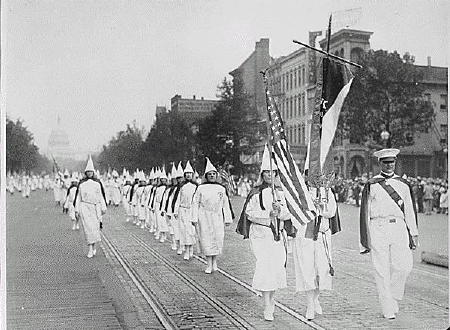
[An unsigned painting, originating in Kansas, from the 1920s.]
Those three burned crosses in North Carolina of a couple weeks ago sure got everyone stirred up. Including, it seems, the Ku Klux Klan:
- The national director of the Ku Klux Klan on Tuesday denied any involvement in the recent burning of crosses in Durham and offered to add to the reward fund for information leading to an arrest and conviction in the case.
"Anybody with a copy machine or a computer can make a flier and incriminate the Klan," said Thomas Robb during a telephone interview Tuesday afternoon. "I'm confident that is what they will find this time."
Heaven forfend that anyone should suspect the Klan of burning crosses, for goodness's sake. When have they ever done anything like that?
And they're, you know, just folks, too:
- In a news release faxed Tuesday to The Herald-Sun, Rachel Pendergraft, the Klan's membership coordinator, said she was concerned that fliers left behind at one of the sites attributed the acts to the Klan.
"Our members are busy raising families, taking part in the business community and volunteering for community programs," Pendergraft said in the release. "Your child's teacher may be a member or perhaps your den's Girl Scout leader is a member.
"I also find it strange that no one would see a group of white people in mostly black areas carrying and mounting 7-foot-tall crosses," the statement says.
But then, as the editors of the Herald-Sun adroitly noted, "wouldn't a group of people of any race seem out of place anywhere if they were carrying and mounting 7-foot crosses?"
It's a typical lame Klan maneuver to try to blame black "agitators" for acts committed by their own members -- or at least their sympathizers. But it may not have been one of Robb's followers, and it still might have been a Klansman. Remember, there are about 110 different Klan organizations (or Klaverns) and four well-known "national" organizations (Robb's Knights of the Ku Klux Klan, the American Knights of the Ku Klux Klan, the Knights of the White Kamelia and the Imperial Klans of America) as well as some lesser groups that aspire to those heights. Finally, there are many thousands of people who probably subscribe to white-supremacist beliefs but do not belong to any organization, and when these folks act, they show no hesitation in adopting traditional racist symbology and rhetoric.
Now, there are indeed false reports of racist violence that turn out to be a hoax or wrong conclusion. But endemic to the hoax cases is a general half-heartedness on the part of perpetrators; the pattern and spread of these burnings suggests a far more serious intent.
However, as with some of these other cases (notably the Lefkow murders), the reaction of the extremist right to the reportage of these incidents is in some ways more noteworthy than the originating incident. And the indignation of these good, upstanding Klan members is worth more than a mere chortle.
Remember, if you will, that at one time the Klan was widely perceived as exactly the kind of good, upstanding Americans and neighbors that Mrs. Pendergraft described it as being even today. The rider in the Klan painting at the top of this post was meant to be seen as heroic, not nightmarish.
The Klan wasn't just a popular civic organization that existed in all 48 states. It was a real political power.
As the Wikipedia entry on the Klan explains:
- The second Ku Klux Klan rose to great prominence and spread from the South into the Midwest and Northern states and even into Canada. At its peak, most of the membership resided in Midwestern states. Through sympathetic elected officials, the KKK controlled the governments of Tennessee, Indiana, Oklahoma, and Oregon in addition to those of the Southern Democratic legislatures. It even claimed to have inducted Republican President Warren Harding at the White House. Klan delegates played a significant role at the 1924 Democratic National Convention in New York City, often called the "Klanbake Convention" as a result. The convention initially pitted Klan-backed candidate William McAdoo against New York Governor Al Smith, who drew the opposition of the group because of his Catholic faith. After days of stalemates and rioting, both candidates withdrew in favor of a compromise. Klan delegates defeated a Democratic Party platform plank that would have condemned their organization. On July 4, 1924 thousands of Klansmen converged on a nearby field in New Jersey where they participated in cross burnings, burned effigies of Smith, and celebrated their defeat of the platform plank.
You can read more about the Klan's brief reign in the 1920s here.
And yes, they had a fairly substantial female contingent, mostly a kind of ladies' auxiliary. Here's a shot of them marching on the Capitol (along with thousands of regular Klansmen) in 1928:

The Klan and its members have always seen themselves as the red-blooded proponents of "100 percent Americanism." That's why they've been working so hard at mainstreaming themselves. They see the post-9/11 environment as a ripe one for their agenda -- and, given the success of right-wing extremists like the Minutemen, they seem to be right so far.
No comments:
Post a Comment